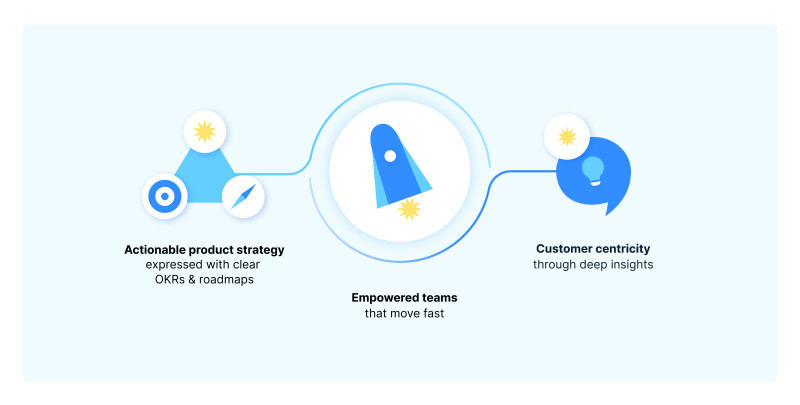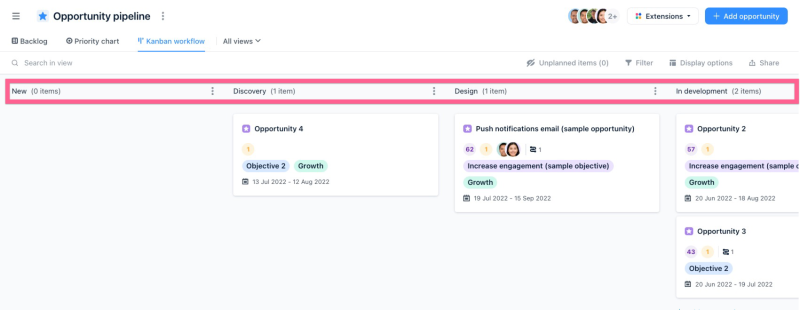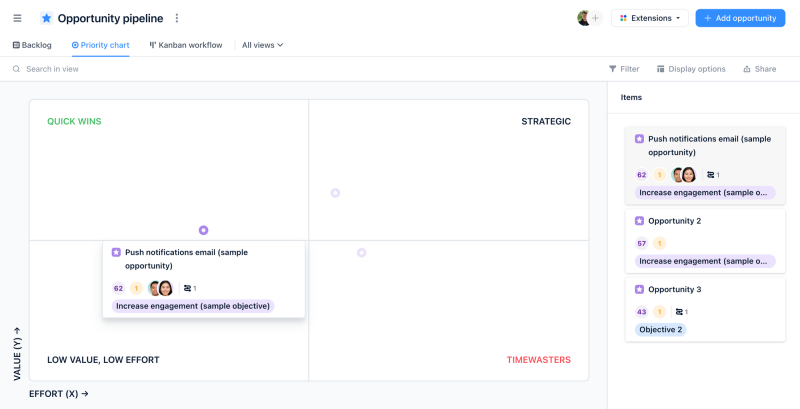How airfocus Supports Modern Product Management
What is modern product management?
As software has eaten the world, product management has become mission-critical for almost all companies and industries. Despite best practices being widely available and discussed, 86% of product managers still claim to be trapped in the “feature factory” and not focusing on outcomes enough.
So what is “good” and modern product management all about?
In line with Marty Cagan, the job of a product manager is “to discover a product that is valuable, viable, usable, and feasible”. Product management has also been defined as the intersection between business, technology, and the customer (also sometimes referred to as “user experience”).
As per these definitions, product management is as much art as science, with the product manager being responsible for the product throughout its entire lifecycle.
Modern product management generates the right kind of outcomes for the business. It does this in the messy environment between technological possibilities and customers’ needs. It’s therefore a function of the following success criteria:
Actionable product strategy: a strategy that achieves business outcomes, expressed with clear roadmaps
Empowered teams: enable each team to build unique discovery to delivery processes so they can solve the hard problems and move fast
Customer-centricity: solve the right problems through centralized feedback and deep insights

Let’s take a look at what this means:
1. Shape an actionable product strategy with clear roadmaps

TL;DR
Product strategy helps you decide what problems you need to solve to realize your vision, while your roadmap describes the path to get there. If you don’t get this level right, your chances of succeeding will be much lower.
Product strategy is the logical plan of how the product will drive its part of the company strategy. It’s about how to make the product vision a reality while meeting the needs of the company as you go.
Your product roadmap is the document that communicates the direction that you are going to take to achieve the goals that the company (or product) is aiming for. It describes the path from where you are now to realizing the vision you have spelled out in your product strategy. Although often referred to as a “roadmap”, a roadmap is not a collection of features that are to be released. That’s what release plans are there for.
An effective product strategy and clear roadmaps have become the most important drivers for a company's success. In the past, they would thrive by simply launching more and more features. Today, that's not enough. Businesses will either win or lose based on the quality of their products and their ability to implement a product strategy appropriate for where the company is at in addressing the right customer needs.
2. Empower each team to build unique discovery to delivery processes so they can solve hard problems faster

TL;DR
The best product organizations make product discovery an integral and continuous part of their processes. They empower their teams to implement discovery and delivery workflows that make sense for them, while still making sure that everything they do is in line with other team’s work as well as the higher-level product strategy and roadmap.
Every company, product team, and product is unique. That’s why you need to live and breathe product management processes that work for you and can empower your cross-functional teams to solve the right problems.
In order to understand where you are today and how to shape the right processes for your unique setup, you can use different methodologies such as the Dual Track Agile or the Double Diamond framework.
What all the modern frameworks have in common is that they differentiate between the problem space (discovery) and the solution space (delivery). Product discovery helps you figure out the problems as well as the tactics that can actually solve the problems, while product delivery builds that solution so you can bring it to market.
The core ideas of modern product discovery and delivery are that 1) discovery is an integral and continuous part of building products users love and 2) that you need to take a whole team approach, where discovery and delivery happen together in a parallel loop.
In reality, this often means PMs, designers, and developers are on the same cross-functional product team, doing both discovery and delivery in parallel.

All these modern frameworks provide guidance, but there are no recipes that will guarantee success.
The magic sauce for product success is that teams within your organization need to have the autonomy and flexibility to implement processes that make sense for them, while still making sure that everything is in line with the higher-level product strategy and roadmap.
This could mean that the web team runs a more modern Dual Track Agile process, while the mobile team has more of a waterfall(-ish) development workflow, because – as an example – they have to ship fewer continuous releases to the app stores. As long as both contribute to and focus on the desired outcomes and roadmap initiatives, teams should be empowered to do what works for them.
3. Customer-centricity through centralized feedback and deep insights

TL;DR
The best product orgs set up a feedback management system that feeds back to the product team and informs the work they're doing to ensure that they’re solving the right problems.
The third dimension of product success is a shared and deep understanding of the needs of users, potential users, customers, and internal stakeholders. The product team can only solve the right problems if they understand and evaluate feedback and link it to their product work (typically their roadmap initiatives, opportunities, epics, or features).
Feedback usually arrives from different channels and in different shapes: Intercom or Zendesk support tickets, sales conversations in Salesforce, and messages from Microsoft Teams and Slack all contain valuable insights for product management.
The best teams develop scalable feedback management workflows by capturing, centralizing, and organizing all that feedback in one place and then using the valuable insights to inform product discovery and delivery.
How to run modern product management in airfocus?
airfocus is built upon the understanding that every product and team is unique and that a product management platform needs to adapt to these unique needs. That's why it is the world's first and only modular product management platform that provides a toolbox to design custom product management workflows. With airfocus’ ready-to-use templates you can easily start with your use case, be it an outcome-based roadmap or an end-to-end PM workflow, and extend airfocus as you grow and scale.
To run a modern end-to-end process, use the “Full product management workflow” template:
The template includes three connected workspaces:
Strategic roadmap (1/3): Manage the what and why of your initiatives and projects. Put all the big items in here and connect them with the opportunities or epics in your Opportunity pipeline(s).
Opportunity pipeline (2/3): Manage your opportunity and epic backlog, run discovery, prioritize what to do next, and turn strategy into action with a timeline view. Often each of your teams has its own Opportunity pipeline to allow the PM and team to run a process that makes sense for them. By linking to the Strategic roadmap you make sure that all teams work towards the same strategic objectives and initiatives.
Feedback & Insights (3/3): Capture and centralize feedback all in one place. Next, create insights from feedback to add to opportunities in your Opportunity pipelines. This workspace helps you with success criteria 3 (customer-centricity through centralized feedback and insights).


Let’s now dive deeper into what each of the three airfocus workspaces can do, how they’re connected, and how they contribute to your modern product management journey.
Strategic roadmap workspace (1/3): Align everyone around an actionable product strategy with clear roadmaps
The Strategic roadmap is the first workspace we’re going to look at. It’s where you will find your high-level initiatives and projects. Build in the now-next-later format, this workspace allows you to visualize your product direction, get alignment, and ensure all your teams are working towards the same goals. You can customize it so you can see objectives, linked opportunities, and even details of project plans.
Benefits of a strategic now-next-later roadmap
Helps you focus on initiatives, goals, and strategy (instead of task work, solutions, and features).
The roadmap spans across teams and products (in airfocus: workspaces) to align around the strategy.
Focus on measurable outcomes (instead of output).
What can you do in this workspace?
Add your initiatives and high-level problems
Your initiatives today probably live in slides, docs, or spreadsheets. You can easily import them through our integrations or the CSV importer.
Configure your product hierarchy
If you have installed the “Full product management workflow” template, this “Strategic roadmap” workspace is already connected with your “Opportunity pipeline” workspace(s) through hierarchy. This means that roadmap initiatives can be parents of your opportunities. With hierarchy you can make sure that you’re only focusing on opportunities (or epics) that have a real impact on the initiatives in the now or next.

You can configure your product hierarchy and how the workspaces connect in your workspace settings.
Share tailored roadmap views with different audiences Curate your roadmaps for specific audiences and seamlessly share them via secure URLs and exports.

Visualize roadmap data with custom views
Depending on the audience and your goals, you may want to visualize your roadmap work in different ways. Along with showing your initiatives on a now-next-later Board view, a simple List view can be a great way to visualize your hierarchy tree.

Use the (Default) Display options to define per view what items to show and how to structure and visualize the data. In the example above you see initiatives nested within objectives (as swimlanes) on a List view.
Related resources
Opportunity pipeline workspace (2/3): Implement a discovery to delivery process that empowers your teams to move fast
Use the Opportunity pipeline workspace to manage your opportunity and epic backlog, focus on the problem space, run discovery workflows, prioritize what to do next, and plan delivery work with timeline views.
If you have multiple teams or products, we often recommend that each team or product gets its own workspace so it can build discovery to delivery workflows that make sense for it. This workspace is a PM’s and product team’s entire universe where they spend most of their time (almost like a “good” silo).
The pipeline is where you push your numerous opportunities, ideas, or epics through a standardized funnel and process from the moment they get created to when they’re being rolled out to your customers and measured for success. By having everything in one place, you can focus on discovery, prioritize with confidence, make informed decisions, and build products people love.
Each opportunity pipeline connects to the Strategic roadmap workspace (through hierarchy) and the Feedback & Insights workspace (through the Insights app) so the team can have a clear focus on strategic initiatives and stay customer-centric.
Benefits of an opportunity pipeline
Provides PMs with a dedicated space where they can set up discovery to delivery workflows that fit the team.
As part of the discovery work, the opportunity pipeline is the place to document your findings. It becomes a source of truth for all your product discovery, research, insights, analyses, etc.
Allows to visualize all the approved work and to monitor progress when things go into delivery (no need for checking epic statuses in Jira anymore).
What can you do in this workspace?
Integrate airfocus with Jira or any other delivery tool
As a single source of product truth, airfocus is the place where your opportunities are first created. However, when any of your opportunities get closer to the delivery stage, you can push them as epics to and sync them with the delivery tool of your choice, be it Jira, Azure DevOps, Asana, Shortcut, and more.
To get started quickly, you can also import your existing epics through the integrations or the CSV importer.
Manage your opportunity and epic backlog
The backlog is the place where you find, organize, and manage all your opportunities, ideas, and epics and their respective field data.

As you learned above already, this Opportunity pipeline workspace is already connected with the Strategic roadmap workspace through hierarchy. This means that you can easily add initiatives as parents to each of your opportunities. This helps you focus on the right strategic initiatives.

Push your opportunities, ideas, and epics through a Kanban pipeline workflow
We recommend managing your never-ending list of opportunities and ideas like a sales funnel, where new opps (just like new sales deals) are being added and then pushed through a pipeline (your discovery and delivery process). The following pipeline stages have continuously shown to improve decision-making and align everyone on what the focus is: new, discovery, design, in development, testing, live, measuring success, and done.

Standardize prioritization with your custom scoring framework
Prioritization is hard. On this level of the product hierarchy, a custom scoring framework via the Priority Ratings app (in airfocus, apps are little tools that solve specific problems) can help you frame your decision-making process and enable better conversations with your teams around which opportunities to pursue. It becomes especially valuable in a later discovery stage when you have a better idea of what the solution to a problem is and roughly what effort it involves.

You can adjust the framework with custom prioritization factors and criteria and even incorporate customer insights. This means that each time there is a new insight for an opportunity (learn more below), the priority score automatically gets updated.

Quite often, you find yourself with just too many ideas and opportunities. Visualizing scores from the Priority Ratings app on a 2x2 chart will help you see the big picture and understand how to prioritize the right opportunities.

Prioritization often (not always) should be a team sport. Gather stakeholders to reach a consensus on product priorities with Priority Poker, an interactive and collaborative way to align around prioritization scores. It allows you to run negotiation meetings more effectively and find gaps around product decisions.

Plan and monitor releases and delivery work with timeline views
When you have prioritized which opportunities to pursue and have started to enter the solution space (delivery), then you will inevitably have planning conversations around when to implement them (at this stage, they might have turned into epics). A timeline view is a great tool in this stage as it allows to visualize dependencies between your items, plan around milestones, account for capacity, and communicate your releases and sprint plans.

Related resources
Feedback & Insights workspace (3/3): Become customer-centric by centralizing and linking feedback to generate insights
Use the Feedback & Insights workspace to capture and centralize feedback from different channels in one place and then organize and segment it in a way that suits your needs.
Next, make sure to regularly look at the incoming feedback together with your team and turn the relevant and valuable feedback pieces into insights by linking them to your opportunities.
Benefits of a centralized and organized feedback repository
Capture, centralize, and organize feedback from all your feedback channels in one place (single source of truth).
Define and live feedback management workflows that fit your needs (there are no one fits all ways to organize, segment, and process feedback).
Link valuable feedback to your product work to always have the feedback at hand when trying to understand problems, opportunities, or features and to track the frequency of feedback and requests.
Close the feedback loop with your customers.
What can you do in this workspace?
Capture, centralize, and organize feedback all in one place
Make sure no information and no requests get lost and that your users are heard by collating feedback from email, chat, support, and other channels in one organized inbox. It’s like a mailbox of the product team where colleagues, customers, and stakeholders can leave raw feedback and ideas. The easiest way to get started is by importing your feedback through our integrations or the CSV importer.

Manage feedback with your own set of workflows Segment, organize, and visualize feedback in whatever way that makes sense for you, be it on an inbox, table, or board view.

Turn valuable feedback into insights to inform product work
With the “Full product management workflow” template, this workspace has the Insights app already pre-installed (and the app is configured in a way so it connects with the “Opportunity pipeline” workspace). So you can get started without the need to configure anything.
With the Insights app, you can generate insights by linking valuable feedback with your opportunities. Simply click on the “Insights” button that you find on any of your feedback items and then highlight the relevant content on the item description with your mouse to create the insights link.

Include customer insights when prioritizing problems
Now that you’ve created the insight, you will find an insight count on the Opportunity pipeline to surface frequently-requested ideas, understand the “why” of your customers' needs, and even make user insights part of your prioritization framework.

Close the customer feedback loop
As a last step of the feedback loop, get back to customers or whoever sent the initial feedback whenever you have an update that matters to them (e.g. the customer problem has been addressed or a requested feature has been shipped).

Related resources
Closing thoughts
Modern product management, by our definition, is about combining well-understood principles and frameworks with an understanding that organizations, teams, and products are unique and therefore, require unique solutions. At the end of the day, it’s about empowering the product teams and product managers to do what works for them. As long as the individuality of each team and workflow is framed by a clear connection to product strategy and rooted in customer centricity, it’s bound for success.
Additional resources around modern product management
Experience the new way of doing product management
